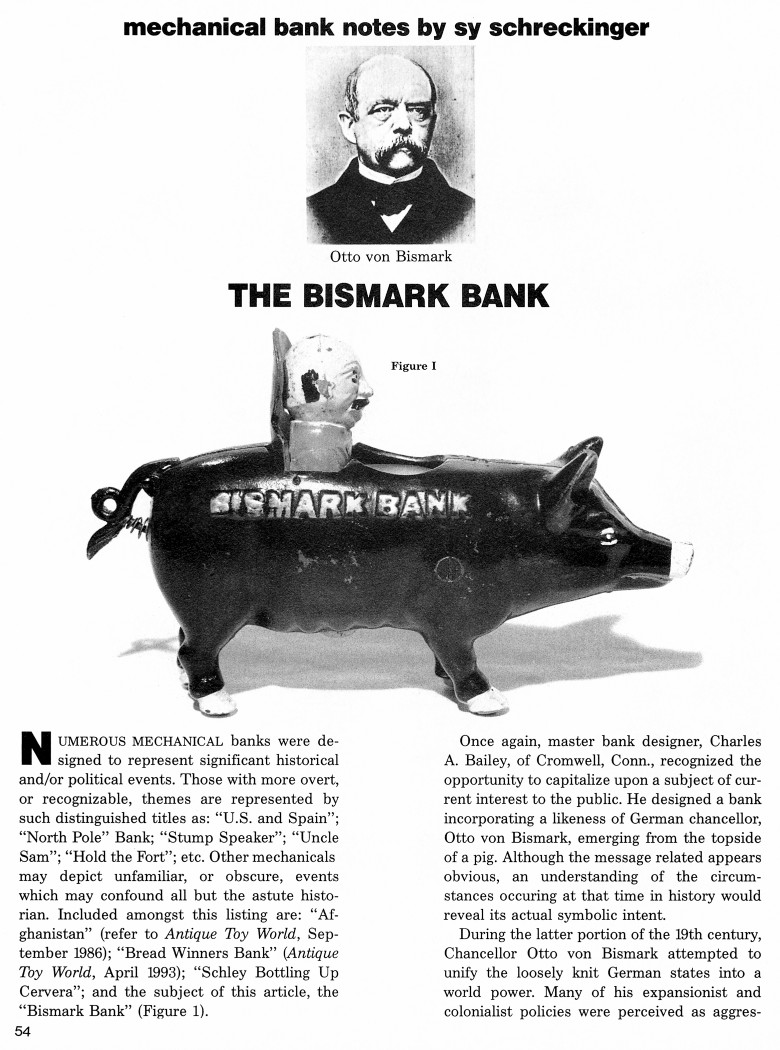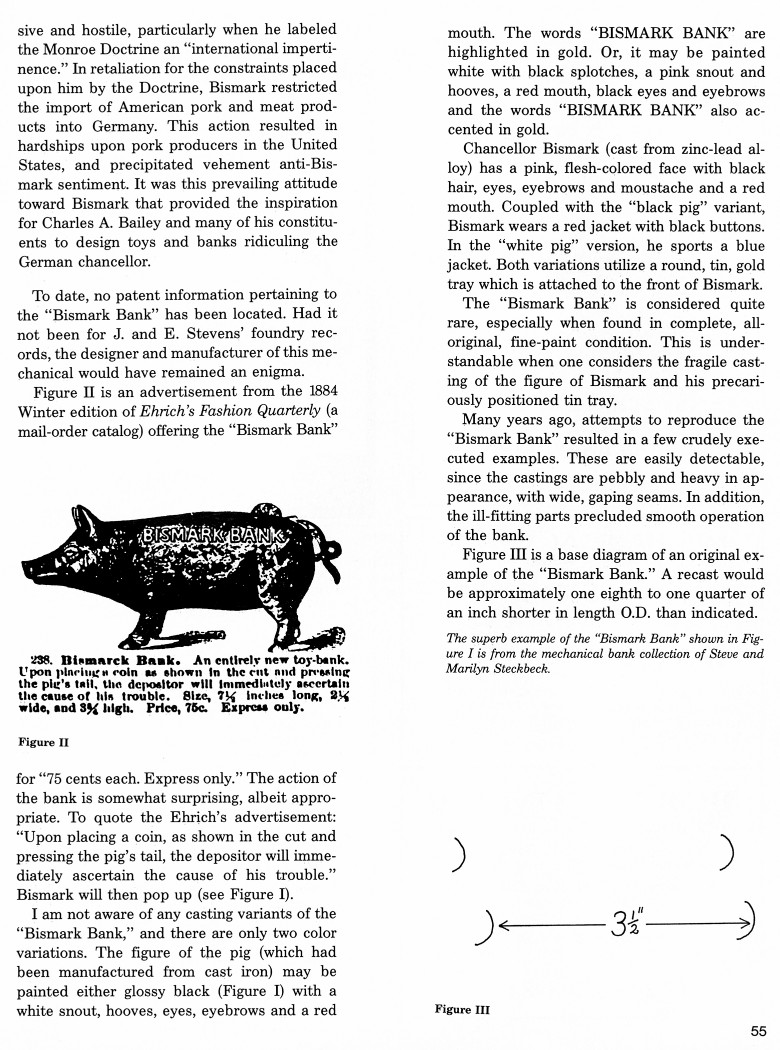|
The Bismark Bank
by Sy Schreckinger – ANTIQUE TOY WORLD Magazine – March, 1995
Numerous mechanical banks were designed to
represent significant historical and/or political events. Those with more
overt, or recognizable, themes are represented by such distinguished
titles as: "U.S. and Spain"; "North Pole" Bank; "Stump Speaker"; "Uncle
Sam"; "Hold the Fort"; etc. Other mechanicals may depict unfamiliar, or
obscure, events which may confound all but the astute historian. Included
amongst this listing are: "Afghanistan" (refer to Antique Toy World,
September 1986); "Bread Winners Bank" (Antique Toy World,
April 1993);
"Schley Bottling Up Cervera"; and the subject of this article, the "Bismark
Bank" (Figure 1).
Once again, master bank designer, Charles A. Bailey, of Cromwell,
Conn., recognized the opportunity to capitalize upon a subject of current
interest to the public. He designed a bank incorporating a likeness of
German chancellor, Otto von Bismark, emerging from the topside of a pig.
Although the message related appears obvious, an understanding of the
circumstances occurring at that time in history would reveal its actual
symbolic intent.
During the latter portion of the 19th century, Chancellor Otto von
Bismark attempted to unify the loosely knit German states into a world
power. Many of his expansionist and colonialist policies were perceived as
aggressive and hostile, particularly when he labeled the Monroe Doctrine
an "international impertinence." In retaliation for the constraints placed
upon him by the Doctrine, Bismark restricted the import of American pork
and meat products into Germany. This action resulted in hardships upon
pork producers in the United States, and precipitated vehement anti-Bismark
sentiment. It was this prevailing attitude toward Bismark that provided
the inspiration for Charles A. Bailey and many of his constituents to
design toys and banks ridiculing the German chancellor.
To date, no patent information pertaining to the "Bismark Bank" has
been located. Had it not been for J. and E. Stevens' foundry records, the
designer and manufacturer of this mechanical would have remained an
enigma. Figure II is an advertisement from the 1884 Winter edition of
Ehrich's Fashion Quarterly (a mail-order catalog) offering the "Bismark
Bank" for "75 cents each. Express only." The action of the bank is
somewhat surprising, albeit appropriate. To quote the Ehrich's
advertisement: "Upon placing a coin, as shown in the cut and pressing the
pig's tail, the depositor will immediately ascertain the cause of his
trouble." Bismark will then pop up (see Figure I).
I am not aware of any casting variants of the "Bismark Bank," and
there are only two color variations. The figure of the pig (which had been
manufactured from cast iron) may be painted either glossy black (Figure I)
with a white snout, hooves, eyes, eyebrows and a red mouth. The words "BISMARK
BANK" are highlighted in gold. Or, it may be painted white with black
splotches, a pink snout and hooves, a red mouth, black eyes and eyebrows
and the words "BISMARK BANK" also accented in gold.
Chancellor Bismark (cast from zinc-lead alloy) has a pink,
flesh-colored face with black hair, eyes, eyebrows and moustache and a red
mouth. Coupled with the "black pig" variant, Bismark wears a red jacket
with black buttons. In the "white pig" version, he sports a blue jacket.
Both variations utilize a round, tin, gold tray which is attached to the
front of Bismark.
The "Bismark Bank" is considered quite rare, especially when found in
complete, all-original, fine-paint condition. This is understandable when
one considers the fragile casting of the figure of Bismark and his
precariously positioned tin tray.
Many years ago, attempts to reproduce the "Bismark Bank" resulted in
a few crudely executed examples. These are easily detectable, since the
castings are pebbly and heavy in appearance, with wide, gaping seams In
addition, the ill-fitting parts precluded smooth operation of the bank.
Figure III is a base diagram of an original example of the "Bismark
Bank." A recast would be approximately one eighth to one quarter of an
inch shorter in length O.D. than indicated.
The superb example of the "Bismark Bank" shown in Figure I is from
the mechanical bank collection of Steve and Marilyn Steckbeck.
|


